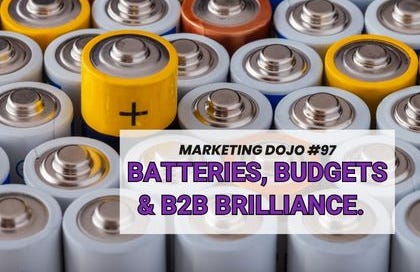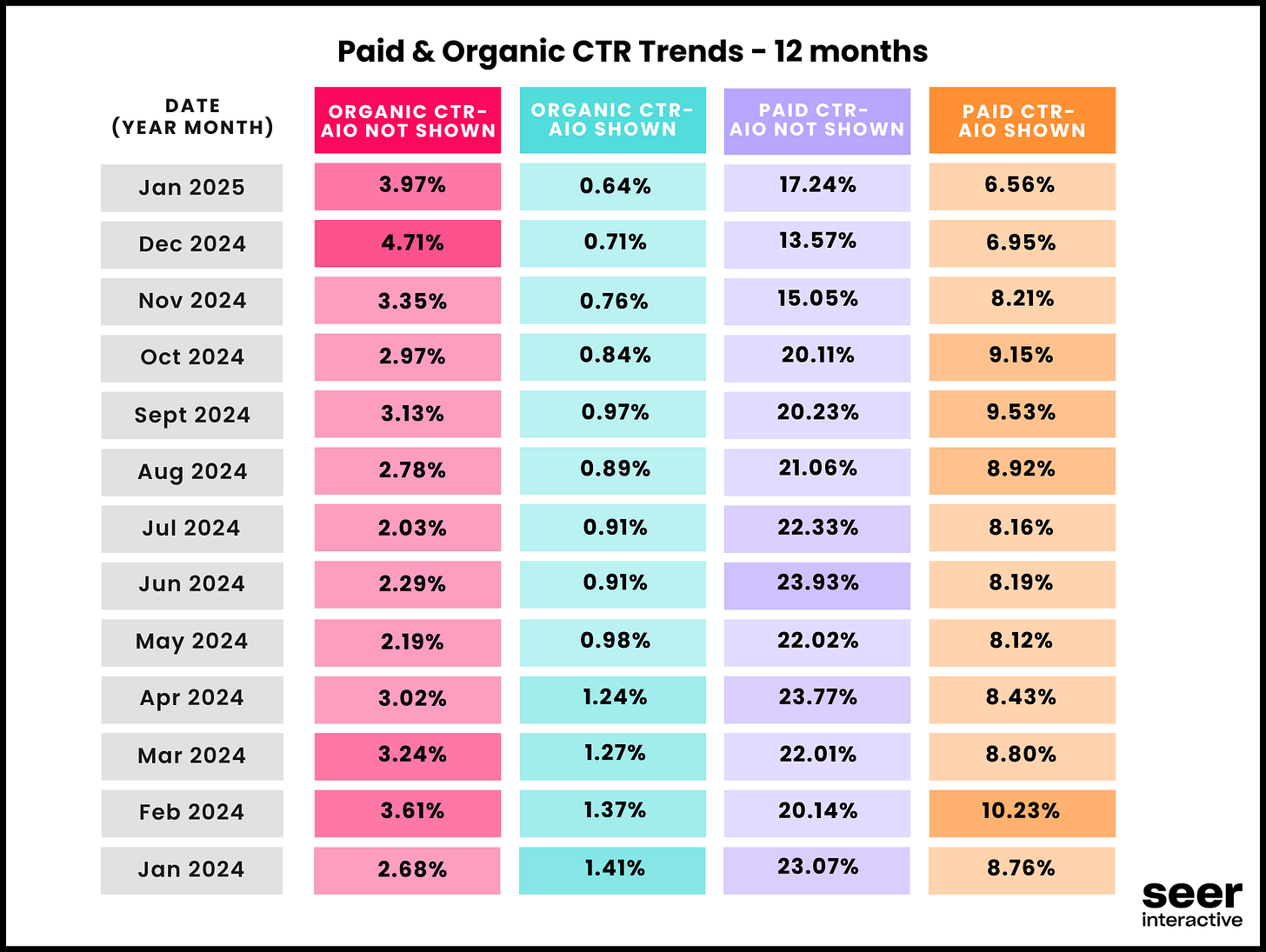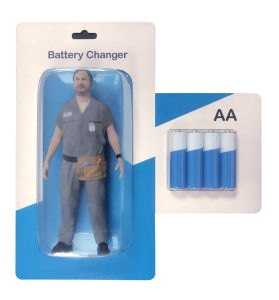MarketingDojo #97: 🔋Batteries , 💰Budgets & ⚡B2B Brilliance.
Google AI Overview's Impact on Ads and Traffic, Procell's Creative Campaign, Nuances in The Paradox of Choice and more.
The Super Bowl just wrapped up, and once again, I found myself in that peculiar position of caring more about the ads than the actual game.
I spent a hot second calculating how many years of my marketing budget would be needed to afford one 30-second, $8 million ad slot. I swear I will never do that kind of scary thinking again!
But like every year, I spent the last few days feeling just a tiny bit powerful.
I am slowly returning to my reality of stretching dollars like rubber bands.
In this week's Marketing Dojo, we're looking at both ends of the marketing spectrum:
🤖 The anti-Midas touch of Google AI Overviews
💡 Creative excellence powered by Procell
🤔 An update to the paradox of choice
📈 Why HubSpot's CMO is unbothered by Google's traffic decline
...and more marketing wisdom that won't cost you $8 million to learn.
Search is down. Next is what?
Google's AI overviews are taking over your feeds.
These snappy, AI-generated summaries now appear in nearly half of all search queries, giving users instant answers without clicking through to websites. Convenient for users? Yes. Good for website traffic? Not so much.
Fresh data from Seer Interactive reveals just how deep this rabbit hole goes. Spoiler alert: both organic and paid search are taking a hit.
The report analyzes click-through rates (CTR) for both organic results and search ads, comparing searches with and without AI Overviews. Here's what's happening:
If your website appears next to an AI Overview, your organic CTR is down by 54% year-over-year. In other words, your search traffic has halved in just 12 months.
But when an AI Overview doesn't appear, organic CTRs have rebounded, up 48% YoY.
Sponsored links are worse off—CTR on search ads is down 62% when shown alongside an AI Overview (as of January 2025).
As Google rolls out AI Overviews more widely, it's not just the organic traffic; search ads aren't the safety net they once were.
AI might have stepped on the gas, but relying heavily on Google search traffic has not been a clever strategy since 2020.
So what can brands do to keep their demand generation engine running despite the chaos? Hubspot's CMO shared some nuggets. (more on this in the newsletter).
Creative Excellence: B2B Marketing Powered by Procell.
Picture this: A procurement manager ordering batteries. Sounds thrilling, right? About as exciting as watching paint dry. Yet somehow, the battery maker Duracell's B2B brand, Procell, turned this mundane purchase decision into a masterclass in B2B marketing in creativity.
Here's the thing about procurement teams - they're juggling hundreds of vendors, from million-dollar software deals that get the CTO's attention to those biscuits filling the pantry shelves. Sorting by price on an Excel sheet is often the easiest default.
But here's the truth across B2B and B2C: buyers aren't just cost-conscious; they're value-conscious. When time and resources are tight, price often becomes a shortcut for value. However, good marketing can find a workable solution.
Enter Procell's "Replace less, save more" campaign, which I discovered through the ON Strategy Showcase podcast. Their stroke of genius?
Making hidden costs impossible to ignore. They sold the true cost of replacement—not just to the end user but to the decision-maker balancing the books.
This campaign is a beautiful mix of wit and wisdom:
A walking, talking money pit. They personified the wasteful process with a character: the perpetual battery changer, forever haunting office hallways.
Absurdity meets reality. The campaign's over-the-top scenarios reflected the absurdity of cutting costs upfront—only to pay far more for downtime and repairs.
A full-funnel blitz. Videos, social, search ads, ROI calculators—even a physical figurine of the battery changer. A tangible reminder of an intangible cost.
Most importantly, Procell let the idea breathe. The campaign ran for about a year before its messaging was updated. The battery changer character and dark humour are now constants, even in the refreshed creative.
Clearly, B2B marketing doesn't have to be boring. It just needs a story worth remembering.
Less Is More? Depends Where You Ask.
Are we drowning in choices? Or starving for them?
Barry Schwartz’s Paradox of Choice made one thing clear—too many options can overwhelm customers, leading to decision paralysis.
A study in the Journal of International Marketing surveyed 7,400 people from six countries—India, China, Japan, Russia, Brazil, and the U.S.- to understand the role of choices in customer satisfaction.
They unearthed some interesting nuances:
• Over HALF of those surveyed felt that they don't have ENOUGH options. While only 14% experience a choice overload.
• The U.S. was the only place where "too many choices" was a frequent complaint. Over 60% of Indians and Brazilians felt choice-deprived.
•In China and Japan, limited choices tank customer satisfaction 90% of the time. In Japan, choice overload has no impact on customer satisfaction at all.
The Paradox of Choice isn't universal—it's cultural. And in many markets, offering more options could be the key to growth.
As marketers and strategists, we're obsessed with simplifying choices. But are we solving a problem our customers don't actually have?
Hubspot’s Pivot From Search to Influence
If you're in marketing, you've probably landed on HubSpot.com while searching for a content template or LinkedIn job title examples. HubSpot’s content factory has been an SEO powerhouse for years.
But recently, the SEO world lit up—SEMRush reported HubSpot’s search traffic was down 80% . Theories flew: Was it content quality? AI Overviews? The end of SEO as we know it?
HubSpot’s CMO and SVP of Marketing, Kipp & Kieran, tackled it head-on in Marketing Against The Grain. Yes, traffic was down. No, not by 80%. More importantly, they shared how HubSpot hedged against Google’s whims by investing in the brand, matching intent to content, and diversifying outreach.
Their big shift? From informational channels to influential media. Instead of waiting for customers to search, become part of what they already consume.
Relying on a single demand channel is a fast track to irrelevance. Give the podcast a listen—it’s a masterclass in future-proofing marketing.
Short Stuff:
Google is testing an internal AI search mode (Built for complex searches).
Amazon attracted new advertisers with ads on Prime Video (You don’t have to sell of Amazon to advertise on Amazon anymore).
Google’s AI ad for the Super Bowl misrepresented its facts. It was corrected before airing during the games. (Someone should’ve warned the folks at Google about hallucinations!).
That’s a wrap on this week. Thank you for your time and attention. If you liked this week’s newsletter or found something interesting, please give me a like ❤️ or drop a comment🗨️. Your support helps drive the newsletter's discoverability.
I will see you in your inbox next Wednesday.
Regards,









